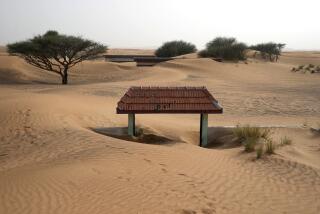Farming Supplants Oil as Economic Hope in Algeria
OUARGLA, Algeria — Deep in the Algerian Sahara, huge circular fields of wheat, oats and barley are sprouting where the average annual rainfall is zero and where no one has put hoe to the soil for more than 12,000 years.
Collapsing world oil prices have transformed parts of this desert where settlements once huddled only near oil rigs. Algeria’s Sahara is converting from black gold to what officials call the Green Gold farm revolution.
When French colonial rule ended 24 years ago, Algeria turned to socialism and sought to use petroleum to build an industrial giant in North Africa.
Most Food Imported
Prosperous French farms along a narrow, irrigated coastal strip were socialized and fell largely into ruin. More than 98% of national income came from oil. Most food was imported from North America and Europe.
Now, President Chadli Bendjedid, faced with a 75% drop in oil and gas income, is opening up the desert to private farmers with land grants, new irrigation methods, subsidies and other incentives.
The need to feed 24 million people--whose numbers increase by 3.3% a year, representing one of the world’s highest growth rates--has swept away old prejudices against private initiative.
The government’s 1985-1989 five-year plan for the first time gives absolute priority to agriculture. Previously barren land, along with equipment and technical aid, is given free to any Algerian who will cultivate it. Price controls on some farm products have been eased.
Underground Reservoirs
The desert soil is fertile, but surface water evaporates under the ever-burning sun. The Algerians are now tapping underground water to make the desert come to life.
More than 12,000 years ago, a pastoral people pictured their rich herds of sheep, goats and cattle on rock walls in colorful paintings still preserved in Algeria’s dry air. They also painted giraffes, elephants, hippos and other wildlife that have long disappeared from the area.
A dramatic change of climate turned the land into part of the world’s largest desert, but vast lakes millions of years old remained trapped underground.
American engineers on contract are using methods already proved successful in Libya and Saudi Arabia. Artesian wells are dug, and the water flows to the surface under its own pressure.
Patchwork of Green
Revolving tubes fixed to a central pivot, and mostly driven just by the pressure from underground, distribute the water evenly. The circular fields, averaging about 2 1/2 acres each, are rapidly changing the landscape into a patchwork of green circles.
Western Agro Management, a U.S. company, has built an initial group of 1,000 such pivot fields, as they are known. The government plans to develop 247,000 more acres within five years.
An Algerian government engineer, banned by official policy from identifying himself for publication, said there is enough water to allow permanent pivot irrigation of more than 1.25 million acres, almost doubling the land under cultivation throughout Algeria.
During the last two years, free land distribution has drawn more than 30,000 small farmers to desert and semi-desert areas, many of them on pivot fields. They grow grain and vegetables, relieving the nation’s critical trade deficit.
Grain Production Leaps
Algeria’s grain production nearly doubled last year to 3 million tons, while vegetable output increased by 27%. The country may soon be self-sufficient in potatoes and, for the first time in 20 years, it is planning food exports to Europe.
But the desert farm program has its problems. Irrigation equipment is fragile, and spare parts are hard to find. Transportation is difficult to the remote fields, and markets are hundreds of miles to the north. Some salty underground water must be filtered.
More to Read
Sign up for Essential California
The most important California stories and recommendations in your inbox every morning.
You may occasionally receive promotional content from the Los Angeles Times.









